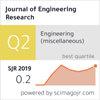利用混合元启发式算法预测铬纳米梁的大变形
IF 2.2
4区 工程技术
Q3 ENGINEERING, MULTIDISCIPLINARY
引用次数: 0
摘要
本文采用混合元启发式方法研究了铬纳米梁的大挠度预测问题。首先,采用实验法的全因子设计,设计了100个实验,其中纳米梁的长度和施加的力分别作为25个和4个水平的输入变量。同时考虑了纳米梁的挠度作为输出。通过回归模型分别用一阶、二阶和三阶方程估计了纳米梁的挠度。初步结果表明,三阶回归模型预测挠度精度高,误差小于其他模型。在下面,为了减少所需的实验次数,使用两个水平的施加力(8和11 nN)来预测挠度。因此,新的方程用于插值和外推在其他水平的力,即9.5和12.5 nN的挠度。最后,采用Big Bang-Big Crunch (BBBC)和Ray Optimization algorithm (ROA)元启发式算法对4级力和2级力得到的三阶方程的系数进行优化。结果表明,BBBC法和RAO法的误差值分别降低了10%和20%。结果表明,用代数公式计算铬纳米梁的挠度具有精度高、实验少、时间短、成本低的优点。本文章由计算机程序翻译,如有差异,请以英文原文为准。
Prediction of large deflection of chromium nanobeams using a hybrid meta-heuristic algorithm
In this paper, the prediction of large deflection of the chromium nanobeams has been studied using hybrid meta-heuristic methods. At first, using the full factorial design of experiment method, 100 experiments were designed in which the length and force applied to the nanobeams were considered as input variables at 25 and 4 levels, respectively. Also, the deflection of the nanobeam was considered as the output. The nanobeam’s deflection was estimated through the regression models by first, second, and third-order equations, respectively. The preliminary results demonstrated that the third-order regression model predicts the deflection with high accuracy and its error is less than the other models. In the following, to reduce the number of required experiments, two levels of the applied force (8 and 11 nN) were used to predict the deflection. Accordingly, the new equations were used for interpolation and extrapolation of the deflection in other levels of forces i.e., 9.5 and 12.5 nN. Finally, the coefficients of both third-order equations obtained by 4 and 2 levels of forces were optimized using the meta-heuristic algorithms i.e., Big Bang-Big Crunch (BBBC) and Ray Optimization algorithm (ROA). Comparing the results showed that by using the BBBC and RAO methods, the error value decreases by 10% and 20%, respectively. The results of this paper showed that the deflections of the chromium nanobeam can be estimated by algebraic formulas with high accuracy and fewer experiments, time, and cost.
求助全文
通过发布文献求助,成功后即可免费获取论文全文。
去求助
来源期刊

Journal of Engineering Research
ENGINEERING, MULTIDISCIPLINARY-
CiteScore
1.60
自引率
10.00%
发文量
181
审稿时长
20 weeks
期刊介绍:
Journal of Engineering Research (JER) is a international, peer reviewed journal which publishes full length original research papers, reviews, case studies related to all areas of Engineering such as: Civil, Mechanical, Industrial, Electrical, Computer, Chemical, Petroleum, Aerospace, Architectural, Biomedical, Coastal, Environmental, Marine & Ocean, Metallurgical & Materials, software, Surveying, Systems and Manufacturing Engineering. In particular, JER focuses on innovative approaches and methods that contribute to solving the environmental and manufacturing problems, which exist primarily in the Arabian Gulf region and the Middle East countries. Kuwait University used to publish the Journal "Kuwait Journal of Science and Engineering" (ISSN: 1024-8684), which included Science and Engineering articles since 1974. In 2011 the decision was taken to split KJSE into two independent Journals - "Journal of Engineering Research "(JER) and "Kuwait Journal of Science" (KJS).
 求助内容:
求助内容: 应助结果提醒方式:
应助结果提醒方式:


